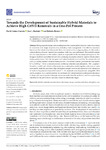Towards the Development of Sustainable Hybrid Materials to Achieve High Cr(VI) Removals in a One-Pot Process

Use este enlace para citar
http://hdl.handle.net/2183/32541Colecciones
- Investigación (FCIE) [1228]
Metadatos
Mostrar el registro completo del ítemTítulo
Towards the Development of Sustainable Hybrid Materials to Achieve High Cr(VI) Removals in a One-Pot ProcessFecha
2022-11-09Cita bibliográfica
Gómez-Carnota, D.; Barriada, J.L.; Herrero, R. Towards the Development of Sustainable Hybrid Materials to Achieve High Cr(VI) Removals in a One-Pot Process. Nanomaterials 2022, 12, 3952. https://doi.org/10.3390/nano12223952
Resumen
[Abstract] Rising manufacturing costs resulting from the current global situation make it necessary to economize at all stages of production, including waste management. Cost-effective materials that reduce the release of pollutants into the environment are becoming mandatory. In this work, a sodium silicate polymeric material, functionalized with iron, was synthesized. The material contains iron-rich nanostructures on the surface, which are responsible for the decontamination process. The inorganic material was further treated with a reducing eucalyptus extract to improve its decontamination performance. Both the inorganic and hybrid materials were used for decontamination of Cr(VI), a widely emitted chemical waste product. The hybrid material provided the best results (1.7 g Cr(VI)·g−1 Fe) in a one-pot process combining reduction and adsorption. The Langmuir–Freundlich model and a statistical thermodynamics adsorption model, together with removal rates, were used to study the processes. High adsorption energies were found, especially in the adsorption of Fe(II) on the polymeric base (33.2 kJ∙mol−1). All materials were characterized using SEM, EDS and N2 sorption, TGA, and IR analyses. In conclusion, the hybrid material synthesized in this study is cheap and easy to produce through environmentally friendly synthesis, and it is a promising adsorbent for the prevention of pollution issues in effluent discharges.
Palabras clave
Hybrid materials
Nanostructures
Chromium
One-pot reaction
Reduction
Adsorption
Iron
Nanostructures
Chromium
One-pot reaction
Reduction
Adsorption
Iron
Descripción
This article belongs to the Special Issue Nano-Adsorbents for the Removal of Heavy Metals and Dyes
Versión del editor
Derechos
Atribución 4.0 Internacional
ISSN
2079-4991






